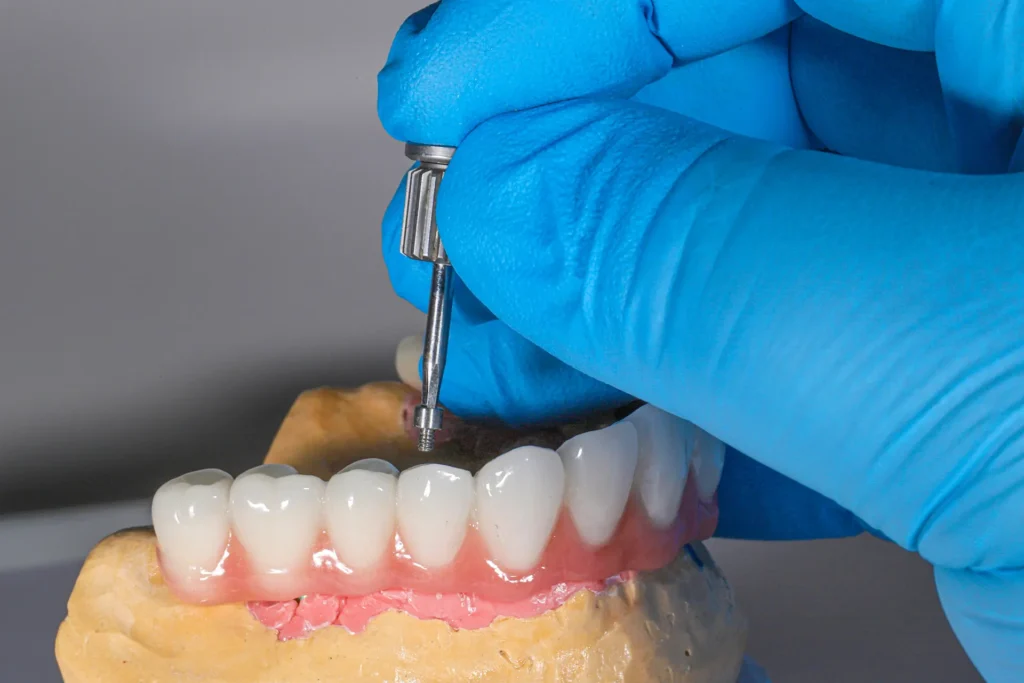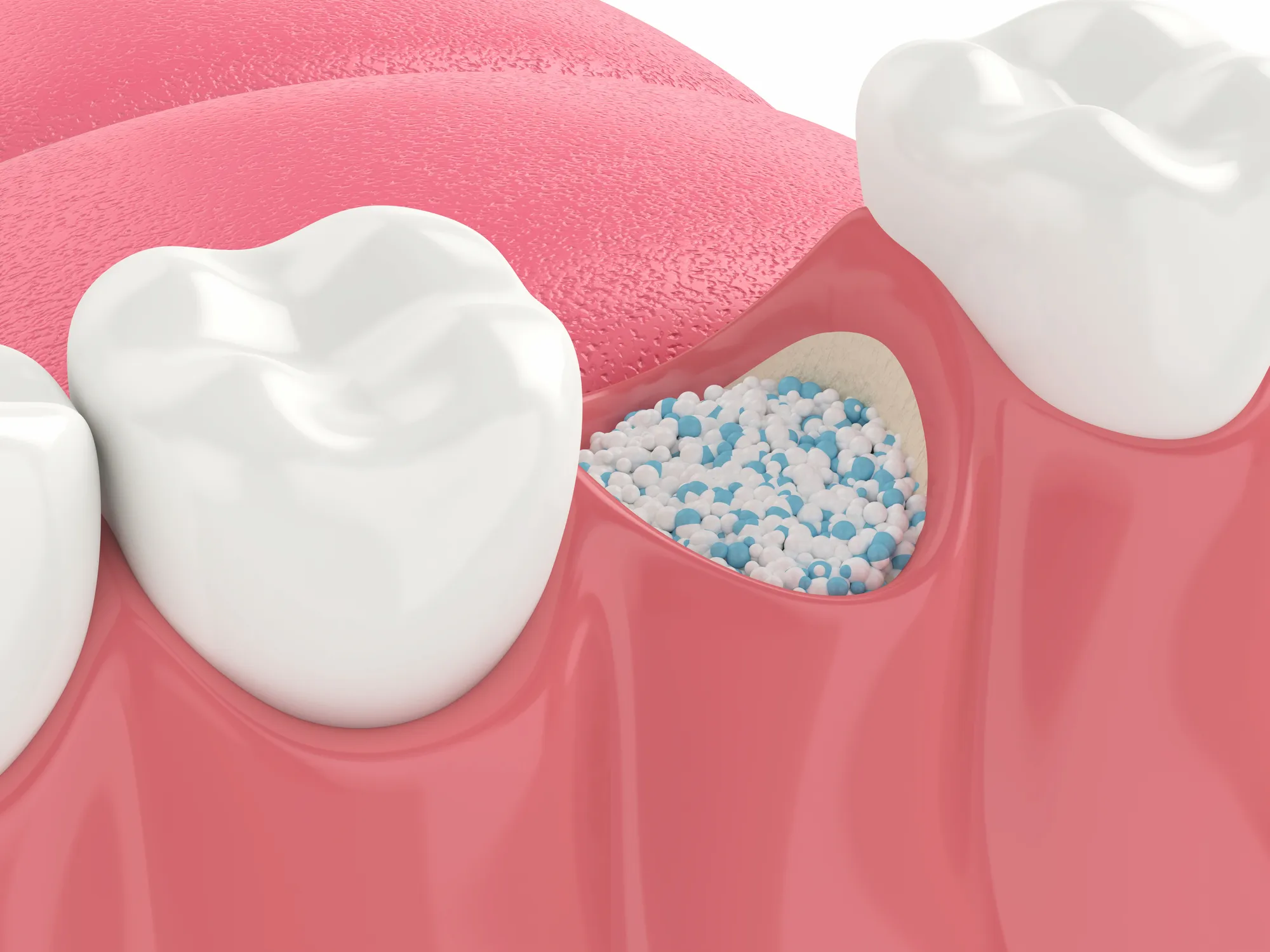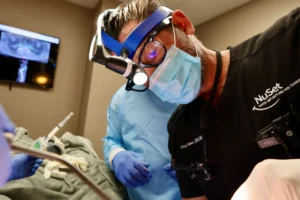Did you know about 1 in 6 adults, 17% aged 65 and older, have lost all of their teeth? When a person loses teeth, it has a direct effect on the jawbone’s health and can lead to significant bone loss in the jaw.
A dental bone graft is a procedure designed to increase the amount of bone in a specific part of your jaw where bone has been lost or where additional support is needed.
In some cases, bone is taken from another part of your body and surgically fused to the existing jawbone. Other times, synthetic bone material is used to achieve the same result.
Bone grafts are essential if you need dental implants, as they provide the necessary support. They are also vital when bone loss affects the health of nearby teeth and gums.
Let’s discuss how dental bone grafts work, the steps involved in the procedure, and what results you can expect from this treatment.
What is a Bone Graft?
A bone graft is a procedure that helps increase the amount of bone in a part of your jaw where bone has been lost or where additional support is needed. This can happen due to gum disease, tooth loss, or injury.
The grafting material can come from your own body, a donor, animals, or be made from synthetic materials. The goal is to provide a stable foundation for dental implants or to maintain the health of nearby teeth and gums.
There are 4 major types of bone grafts, and each depends on your specific dental needs:
-
Autograft
This type of bone graft uses bone taken from another part of your body, usually the hip or another part of your jaw. It has the highest success rate because it uses your own bone tissue, which is most compatible with your body.
-
Allograft
This involves using bone from a human donor. The donor bone is processed to ensure it is safe for use and then grafted into your jaw. Allografts are commonly used because they avoid the need for a second surgical site to harvest bone from your own body.
-
Xenograft
This type of graft uses bone from an animal, typically a cow. The bone is processed to make it safe for human use. Xenografts are useful when a large amount of bone is needed.
-
Alloplast
This involves using synthetic bone material. These materials are specially designed to promote bone growth and integrate with your existing bone. They are a good option for those who prefer not to use human or animal bones.
Why Bone Grafts are Needed
Bone grafts are vital for several reasons. They provide the necessary support for dental implants and help maintain the overall health of your jaw and teeth.
They provide great support for dental implants
When you lose a tooth, the bone in that area can deteriorate over time. A bone graft creates a stable foundation for dental implants, ensuring they are securely anchored and can function like natural teeth.
Bone grafts help to prevent bone loss
After tooth loss, the jawbone can shrink and weaken. Bone grafts help prevent this by stimulating new bone growth and maintaining the structure of your jaw.
They improve oral health
Bone grafts can improve the overall health of your mouth. They provide support for surrounding teeth and gums, preventing further dental issues and ensuring a strong, healthy jawbone.
Procedure for Bone Grafting at NuSet Dental Implants and Oral Surgery
Bone grafting at NuSet is a straightforward procedure designed to ensure the best outcome for your dental health. Here’s a detailed look at how we perform this vital procedure.
Consultation
Your journey begins with a thorough consultation. Our dental professionals will evaluate your oral health, discuss your needs, and determine the best type of bone graft for your situation.
Preparation
On the day of the procedure, we prepare the grafting material. If we use your own bone, we will take it from a suitable site, such as your hip or another part of your jaw. If we use donor or synthetic bone, we ensure it’s ready for placement.
Grafting
During the procedure, we will numb the area with local anesthesia. If needed, sedation can be used to make you more comfortable. We then lift the gum tissue to expose the bone and place the grafting material where it is needed. The graft is secured with small screws or pins to ensure it stays in place.
Closing
Once the graft is in place, we carefully close the gum tissue with stitches. This helps to protect the graft as it heals and integrates with your natural bone.
Recovery
After the procedure, we provide detailed aftercare instructions to promote healing and prevent complications. You will also need to follow a soft food diet for a few days and avoid certain activities, like swimming, running, and jumping, to ensure the graft heals properly.
Our team at NuSet is dedicated to making sure you feel informed and comfortable throughout the entire process. We are here to answer any questions you may have and to support you every step of the way.
Risks and Complications
While bone grafts are generally safe, like any surgical procedure, they come with some risks and potential complications. Understanding these risks can help you feel more prepared and know what to watch for during recovery.
Infection
One of the most common risks is infection. We will prescribe antibiotics to help prevent this. Following the prescribed dosage and completing the entire course of antibiotics is essential.
Rejection of the graft
Sometimes, the body may reject the graft material. This is more likely done with donors or synthetic materials. Signs of rejection include increased pain, swelling, or redness around the graft site.
Bleeding and swelling
Some bleeding and swelling are normal after a bone graft. However, if bleeding is heavy or doesn’t stop after applying pressure, or if swelling persists or worsens after a few days, contact your dentist.
Nerve damage
In rare cases, bone grafting can affect nearby nerves, leading to numbness or tingling in the lips, gums, or tongue. This is usually temporary but can sometimes be permanent.
Pain
Some discomfort is expected after surgery, but severe or persistent pain should be reported to your dentist. They can adjust your pain management plan or check for any complications.
Sinus problems
For grafts in the upper jaw, there is a risk of sinus complications. If the graft material enters the sinus cavity, it can cause congestion or infection. We will discuss ways to minimize this risk.
Are You Ready to Improve Your Dental Health?

Bone grafts are essential for the success of dental implants and the overall health of your jaw and teeth. They provide the support needed for implants, prevent further bone loss, and enhance the stability of your oral structure.
At NuSet Dental Implant and Oral Surgery, we are dedicated to providing you with the best care and information to ensure successful outcomes. If you have any questions or concerns, our team is here to support you every step of the way. Contact us now to learn more about bone grafting and how it can benefit your dental health.
Frequently Asked Questions
How painful is a bone graft for a dental implant?
The pain level for a bone graft can vary from person to person. Most patients experience some discomfort and swelling after the procedure, but this can usually be managed with prescribed pain medication and ice packs. The pain is typically more noticeable in the first few days and gradually decreases as you heal.
Is a bone graft necessary for a dental implant?
A bone graft is necessary if you don’t have enough natural bone in your jaw to support a dental implant. This can be due to bone loss from gum disease, tooth loss, or injury. The graft provides a solid foundation for the implant, ensuring its stability and longevity. Without a sufficient bone structure, the implant may fail.
How long does a dental bone graft last?
A dental bone graft is designed to be a permanent solution. Once the graft has integrated with your natural bone, it should last a lifetime, providing a strong foundation for your dental implants. The success of a bone graft depends on proper care and following your dentist’s instructions during the healing process.
What happens if you don’t get a bone graft?
If you don’t get a bone graft when it’s needed, you might not be able to receive dental implants. Insufficient bone can lead to implant failure, as the implant won’t have the necessary support. Additionally, a lack of bone can result in further bone loss and affect the health of nearby teeth and gums.
Is dental bone grafting expensive?
The cost of dental bone grafting can vary depending on the type of graft used and the extent of the procedure. The cost of a dental bone graft at NuSet is always included in the implant pricing. Factors like the need for additional treatments, the complexity of the case, and the dentist’s experience can also affect the overall cost. Dental insurance may cover some of the expenses, but it’s essential to check with your provider.





